(Trice Edney Wire) – On its 100th anniversary, the 1921 massacre in Tulsa, Oklahoma has finally come to national attention. The history of the massacre is now known. The damage inflicted clear. The question is what is to be done to repair the damage?
In the early 20th century, the Greenwood neighborhood in Tulsa, Oklahoma, was a center of Black economic prosperity in the U.S. Often called the Black Wall Street, Greenwood supported around 15,000 people. It had close to 200 Black-owned businesses, 15 doctors, two dentists, law offices, restaurants, movie theaters, hotels, a hospital and schools.
Greenwood was a prosperous community on the Black side of segregated Tulsa. That made it a source of envy and of resentment. In the early hours of June 1, 1921, a “deputized” white mob — some estimates report it numbering 10,000 persons, supported by the Tulsa police and the mayor of Tulsa — swept through the community, burning, looting and murdering in a calculated act of mass terror.
The trigger for the mob violence was a rumored attack on a white woman by a Black man — a charge that was later dismissed when it turned out that the supposed assailant accidentally tripped into her. As many as 400 Black residents were killed, more than 1,200 homes burned, 10,000 people were left homeless, churches, schools and a hospital were destroyed. There were no convictions for any of the charges related to the violence. Blacks in Tulsa were the most arrested and the most denied.
The dead were buried in mass graves never to be seen again. “Decades of Black prosperity and millions of dollars in hard-earned wealth were wiped out in hours, but nobody was ever held accountable, and no compensation was ever paid,” concluded a report by Human Rights Watch. Last week, three survivors of the incident — all over 100 years old — testified before Congress about the terror and injustice. No one now doubts the damage wrought.
The question is what is to be done to rectify the harm done? In many instances, the survivors and the heirs still have title to the lands and buildings that were torched and forcibly seized from their relatives. Do the descendants have the right to take back the land? In most cases, restitution must be considered for the land and business owners. Many have deeds to the stolen property. They deserve restitution.
The multigenerational damages are staggering. The Stratford Hotel, for example, was worth about $125,000 at the time it was torched. In today’s dollars, it would be worth over $100 million. Restitution calls for returning to the rightful owner something that has been taken away improperly. Reparations is a broader concept, calling for compensation to make good damages that cannot simply be rectified. Many commissions have called for reparations for the victims of the Greenwood massacre, but to date nothing has been done.
Last September, descendants of the victims and Lessie Benningfield Randle, a 106-year-old survivor of the massacre, filed suit against the City of Tulsa and other official bodies. They accurately charged that Tulsa officials permitted and participated in the destruction of their families’ homes and businesses, and that the City of Tulsa also worked to block any compensation from insurance companies.
They asked for a detailed accounting of the property and wealth lost or stolen, the building of a hospital in northern Tulsa to replace the one that was burned down, establishment of a fund to recompense the victims and their descendants, and a break from city and county taxes for survivors or descendants of those who were killed or injured.
Reparations are, of course, controversial, but correct. Basic justice requires some remedy for wrongs committed. And no community can come together without wrestling directly and honestly with the horrors committed and the damage caused. The Tulsa massacre is not the only incident of racial terrorism in this country. Tulsa is a metaphor for all the other race massacres that have occurred in the U.S. In the end, the following must happen: Lynching must be a federal crime. Sen. Rand Paul of Kentucky blocked it.
A Marshall Plan is needed to secure and restructure institutions for fairness and justice. The most significant piece of the Marshall Plan is 50-year development loans at 2 percent, government secured with quarterly returns. How the citizens, the city and state and the courts handle this question will reveal much about the state of justice in this country.




